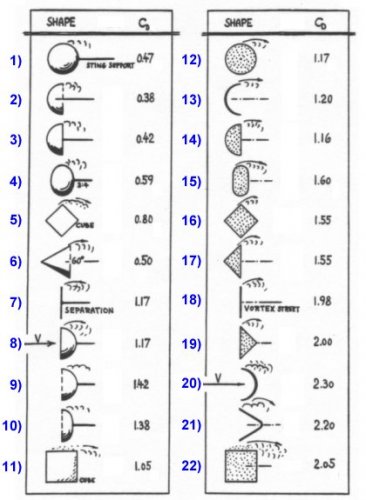You are using an out of date browser. It may not display this or other websites correctly.
You should upgrade or use an alternative browser.
You should upgrade or use an alternative browser.
Looking for the source of some Aerodata
- Thread starter Gildasd
- Start date
martinbayer
ACCESS: Top Secret
- Joined
- 6 January 2009
- Messages
- 2,535
- Reaction score
- 2,314
According to this link http://physics.stackexchange.com/questions/201633/what-shape-has-the-highest-drag-coefficient, it's Figure 33 from Sighard Hoerner's Fluid Dynamic Drag, Chapter 3.
Martin
Martin
Gildasd
Space fantasist
Sir, I thank you!martinbayer said:According to this link http://physics.stackexchange.com/questions/201633/what-shape-has-the-highest-drag-coefficient, it's Figure 33 from Sighard Hoerner's Fluid Dynamic Drag, Chapter 3.
Martin
How the hell did you find this?
Gildasd
Space fantasist
I'll explore that... Thanks again!Dragon029 said:Using Google reverse image search works.
martinbayer
ACCESS: Top Secret
- Joined
- 6 January 2009
- Messages
- 2,535
- Reaction score
- 2,314
Gildasd said:Sir, I thank you!martinbayer said:According to this link http://physics.stackexchange.com/questions/201633/what-shape-has-the-highest-drag-coefficient, it's Figure 33 from Sighard Hoerner's Fluid Dynamic Drag, Chapter 3.
Martin
How the hell did you find this?
I did a Google search for "shape" and "drag coefficient" and looked at the image results.
Martin
Gildasd
Space fantasist
I missed it... Feeling a bit silly now.martinbayer said:I did a Google search for "shape" and "drag coefficient" and looked at the image results.Gildasd said:Sir, I thank you!martinbayer said:According to this link http://physics.stackexchange.com/questions/201633/what-shape-has-the-highest-drag-coefficient, it's Figure 33 from Sighard Hoerner's Fluid Dynamic Drag, Chapter 3.
Martin
How the hell did you find this?
Martin
Went through so many links with so many variations that I did not bother reading the text above the image. "Slaps forehead"
Thanks again.
Gildasd
Space fantasist
When a shape creates a Karman Vortex street behind it, can it be argued that it is hight drag at that Reynolds number/wind speed?
Using maths, it seems to be the case, but I can't find a quote in a reliable scientific paper linking the two...
Any ideas on sources for this?
Using maths, it seems to be the case, but I can't find a quote in a reliable scientific paper linking the two...
Any ideas on sources for this?
Similar threads
-
-
-
Looking for footage of the WW2 British Churchill tank climbing hills
- Started by Bulo
- Replies: 0
-
-

